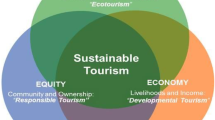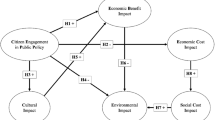Abstract
Valley economy is a type of economy that comprehensively utilizes the natural economic and social resources of the region based on environmental protection. This economy utilizes the basic role of the market in disposing resources and achieving regional development and social progress. In this paper we studied the town of Yanqi, a valley resort that has developed tourism-based valley economy for several years in the mountainous area of Beijing. This research identifies the spatial differentiation of tourism-related economic, socio-cultural, and environmental impact and level of support for tourism according to the perception and attitude of residents of Yanqi. The research area was divided into three zones (i.e., core, transition, and peripheral) according to the standard proposed by Jaakson. The residents in all three zones showed a positive attitude toward the tourism industry, and the residents in the core zone had a stronger perception toward the impact of tourism. However, several items indicated the converse. Correlation analysis and analysis of variance were used to explore the correlative factors associated with the attitudes of residents toward the tourism industry. Results indicated major differences among the three zones. Multiple factors, including natural conditions, policies, scenic spots, dependence on the tourism industry, and external investment in the three zones resulted in the spatial differentiation of the perception and attitude of residents toward the impact of tourism.
Similar content being viewed by others
References
Andereck K, Nyaupane GP (2011) Exploring the nature of tourism and quality of life perceptions among residents. Journal of Travel Research 50: 248–260. DOI: 10.1177/0047287510362918
Andereck K, Vogt C (2000) The relationship between residents’ attitudes toward tourism and tourism development options. Journal of Travel Research 39: 27–36. DOI: 10.1177/004728750003900104
Brunt P, Courtney P (1999) Host perceptions of sociocultural impacts. Annals of Tourism Research 26: 493–515. DOI: 10.1016/S0160-7383(99)00003-1
Tosun C (2002) Host perceptions of impacts—a comparative tourism study. Annals of Tourism Research 29(1): 231–253. DOI: 10.1016/S0160-7383(01)00039-1
Chen B, Liu Q (2009) Research on the implement model of economic organizations. Journal of Beijing Agricultural Vocation College 23: 31–34. (In Chinese)
Chen J H, Zhu M, Lian D (2011a) Study on economic development model and approach of Beijing’s mountainous valley areas, Procedia Environmental Sciences 10: 198–202. DOI: 10.1016/j.proenv.2011.09.034
Cohen E (1988) Tourism and aids in Thailand. Annals of Tourism Research 15: 467–486. DOI: 10.1016/0160-7383(88)90044-8
Doxey G (1975) A causation theory of visitor-resident irritants: methodology and research inferences. Travel and Tourism Research Association 6: 15–18
Fan S Y, Lu J, Wei H W (2009) The study on the system of valley economy in xizang. Journal of Southwest University for Nationalities (Humanities and Social Science) 12: 72–76. (In Chinese)
Gartner W (1996) Tourism development principles, processes and policies. Van Nostrand Reinold, New York, NY, USA.
Gee C, Mackens J, Choy D (1989) The travel industry. Van Nostrand Reinhold. New York, NY, USA.
Gilbert D, Clark M (1997) An exploratory examination of urban tourism impact, with reference to residents attitudes in the cities of Canterbury and Guildford. Cities 14: 343–352.
Gursoy D, Chi, CG, Dyer P (2010) Local’s attitudes toward mass and alternative tourism: The case of Sunshine Coast, Australia. Journal of Travel Research 49: 381–394. DOI: 10.1177/0047287509346853
Gursoy D, Chen J, Yoon Y (2000) Using structural equation modeling to assess the effects of tourism impact factors and local residents support for tourism development. 31st Annual Travel and Tourism Research Association Conference Proceedings. San Fernando Valley, CA, USA. pp 243–250.
Hammitt W, Bixler R, Noe F (1996) Going beyond importanceperformance analysis to analyze the observance: influence of park impacts. Journal of Park and Recreation Administration 14: 45–62.
Haralambopoulos N, Pizam A (1996) Perceived impacts of tourism: The case of Samos. Annals of Tourism Research 23: 503–526. DOI: 10.1016/0160-7383(95)00075-5
Hillery M, Nancarrow B, Griffin G, et al. (2001) Tourist perceptions of environmental impact. Annals of Tourism Research 28: 853–867. DOI:10.1016/S0160-7383(01)00004-4
Husbands W (1989) Social status and perception of tourism in Zambia. Annals of Tourism Research 16: 237–253. DOI:10.1016/0160-7383(89)90070-4
Jaakson R (2004) Beyond the Tourist Bubble? Cruise ship Passengers in Port. Annals of Tourism Research 31: 44–60. DOI: 10.1016/j.annals.2003.08.003
Jafari J (1973) The role of tourism in the socio-economic transformation of developing countries. Published master’s thesis, Cornell University, Ithaca.
Jafari J (1986) Systemic view of sociocultural dimensions of tourism. In the President’s Commission on Americans Outdoors. pp 33–50.
Jiang CG, Li H, Chen JG (2011) Industrial integration development in Beijing mountainous valley areas. Chinese Agricultural Science Bulletin 27: 104–109. (In Chinese)
Johnson J, Snepenger D, Akis S (1994) Residents’ perceptions of tourism development. Annals of Tourism Research 21: 629–642. DOI: 10.1016/0160-7383(94)90124-4
King B, Pizam A, Milman A (1991) Social impacts of tourism: host perceptions. Annals of Tourism Research 20: 650–665. DOI: 10.1016/0160-7383(93)90089-L
Lankford SV, Howard D (1994) Developing a tourism impact attitude scale. Annals of Tourism Research 21: 121–139. DOI: 10.1016/0160-7383(94)90008-6
Lankford S (1994) Attitudes and perceptions towards tourism and rural regional development. Journal of Travel Research 32(3): 35–43. DOI: 10.1177/004728759403200306
Lee C, Kang S K, Long P, Reisinger Y (2010) Residents’ perceptions of casino impacts: A comparative study. Tourism Management 31: 189–201. DOI: 10.1016/j.tourman.2009.02.011
Lepp A (2007) Residents’ attitudes towards tourism in Bigodi village, Uganda. Tourism Management 28: 876–885. DOI: 10.1016/j.tourman.2006.03.004
Liu CL, Zhang YF, Xu M, et al. (2012) Geographic type identification of valley economy: a case of mentougou district in Beijing, china. Scientia Geographica Sinica 32:39–40. (In Chinese)
Liu D, Cao H (1999) Landuse kinds and characteristics of Beijing’s mountain area. Chinese Agricultural Resources and Regional Planning 20: 24–25. (In Chinese)
Liu J, Sheldon P, Var T (1987) Resident perception of the environmental impacts of tourism. Annals of Tourism Research 14:17–37. 10.1016/0160-7383(87)90045-4
Liu JY (2008) Research of self-driving tourist’s behavior. Beijing Forestry University: 25–26. (In Chinese)
Madrigal R (1993) A Tale of tourism in two cities. Annals of Tourism Research 20: 336–353. DOI: 10.1016/0160-7383(93) 90059-C
McCool S, Martin S (1994) Community attachment and attitudes towards tourism development. Journal of Travel Research 32(3): 29–34. DOI: 10.1177/004728759403200305
Milman A, Pizam A (1987) Social impact of tourism on central Florida. Annals of Tourism Research 15: 91–204. DOI: 10.1016/0160-7383(88)90082-5
Ministry of Tourism (1992) Residents’ perceptions and acceptance of tourism in selected New Zealand communities. Ministry of Tourism, Wellington, New Zealand.
Nunkoo R, Gursoy D (2012) Residents’ support for tourism An Identity Perspective. Annals of Tourism Research 39: 243–268. DOI: 10.1016/j.annals.2011.05.006
Perdue R, Long P, Allen L (1987) Rural resident tourism perceptions and attitudes. Annals of Tourism Research 14: 420–429. DOI: 10.1016/0160-7383(87)90112-5
Perdue R, Long P, Allen L (1990) Resident Support for Tourism Development. Annals of Tourism Research 17: 586–599. DOI: 10.1016/0160-7383(90)90029-Q
Reid L, Boyd A (1991) The social impacts of tourism and their effects on attitudes toward a major cultural attraction. In Travel and Tourism Association 22nd Annual Proceedings. Salt Lake City, UT, USA. pp 123–133.
Shi YJ, Tang H, Huang YH, et al. (2009) Valley economy development in Beijing mountain region. Chinese Agricultural Science Bulletin 25: 500–503. (In Chinese)
Su Q, Lin BY (2004) Classification of Residents in the tourist attractions based on attitudes and behaviors: a case study in Xidi, Zhouzhuang and Jiuhua Mountain. Geographical Research 23: 104–114. (In Chinese)
Teh L, Cabanban AS (2007) Planning for sustainable tourism in southern Pulau Banggi: an assessment of biophysical conditions and their implications for future tourism development. Journal of Environmental Management 85(4): 999–1008. DOI: 10.1016/j.jenvman.2006.11.005
Teye V, Sinmez SF, Sirakaya E (2002) Residents’ attitudes toward tourism development. Annals of Tourism Research 29: 668–688. DOI: 10.1016/S0160-7383(01)00074-3
Torres RM, Momsen JD, Gringolandia (2005) The construction of a new tourist space in Mexico. Annals of Association of American Geographers 95(2): 314–335. DOI: 10.1111/j.1467-8306.2005.00462.x
Tosun C (2002) Host perceptions of impacts: A comparative tourism study. Annals of Tourism Research 29: 231–253. DOI: 10.1016/S0160-7383(01)00039-1
Wang L, Lu L (2005) A study summary of the impact of the perception and attitude of overseas residents in tourist destinations on tourism and its enlightenment. Tourism Tribune 3: 87–93. (In Chinese)
Wang H, Yang Z, Chen L, et al. (2010) Minority community participation in tourism: a case of Kanas Tuva villages in Xinjiang, China. Tourism Management 31(6): 759–764. DOI: 10.1016/j.tourman.2009.08.002
Weaver D, Lawton L (2001) Resident perceptions in the urban-rural fringe. Annals of Tourism Research 28(2): 439–458. DOI: 10.1016/S0160-7383(00)00052-9
Williams DR, Patterson ME, Roggenbuck JW (1992) Beyond the commodity metaphor: Examining emotional and symbolic attachment to place. Leisure Sciences 14: 29–46. DOI: 10.1080/01490409209513155
Wu CX, Liu RH, He WY (2010) Marketing development of mountain ecotourism in Beijing valley economy. Chinese Agricultural Science Bulletin 26: 400–404. (In Chinese)
Yang WG (2009) The study on ecosystem of valley economy. China Rural Science & Technology 10: 62–65. (In Chinese)
Yi ZJ, Cao J, Chen JH (2011) The study on economic development mode of Wuye valley. The Conference Proceeding of the leisure agriculture in 2011. (In Chinese)
Zhang YF, Jia DM, Tan J, et al. (2009) The spatial structure of valley economy development in the mountainous areas of Beijing, Acta Geographica Sinica 64: 1231–1242. (In Chinese)
Author information
Authors and Affiliations
Corresponding author
Rights and permissions
About this article
Cite this article
Li, Ss., Liu, Jm., Wang, R. et al. Spatial differentiation of tourism impact based on the perception of residents in mountainous valley resorts. J. Mt. Sci. 11, 1070–1084 (2014). https://doi.org/10.1007/s11629-012-2440-4
Received:
Accepted:
Published:
Issue Date:
DOI: https://doi.org/10.1007/s11629-012-2440-4




